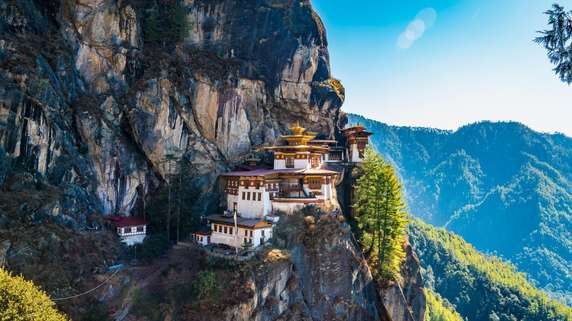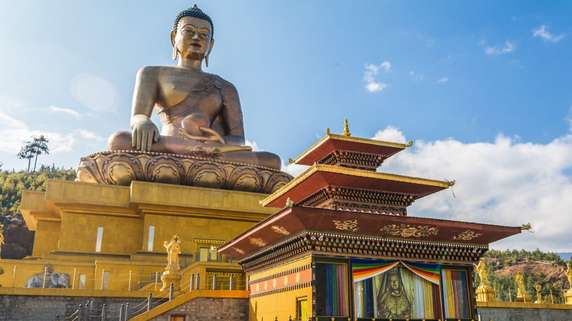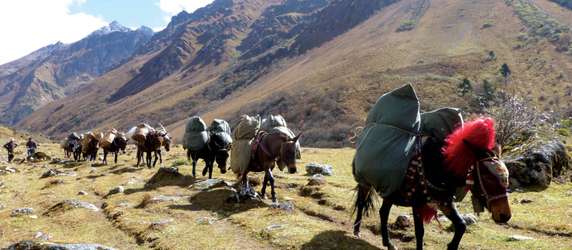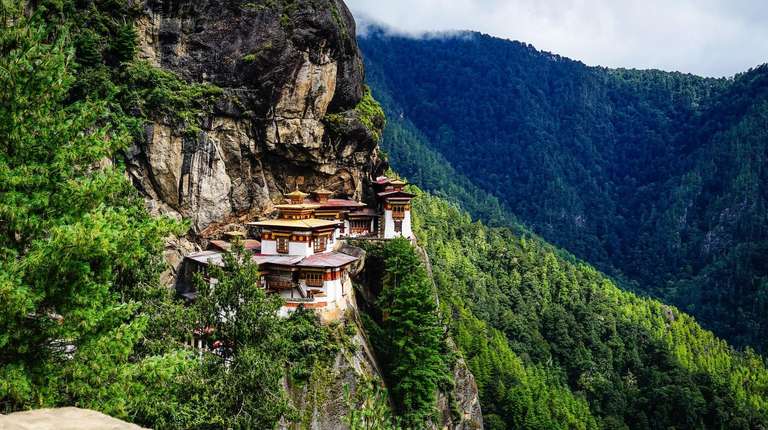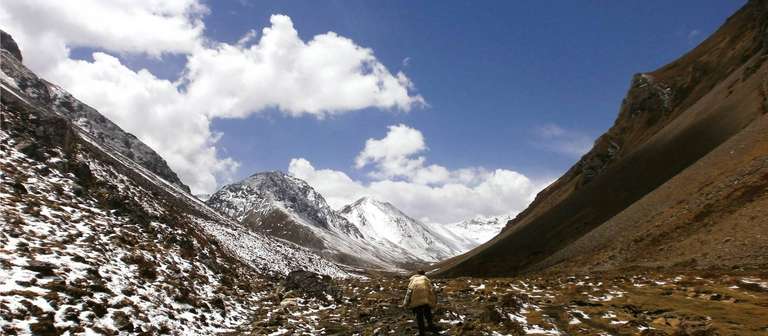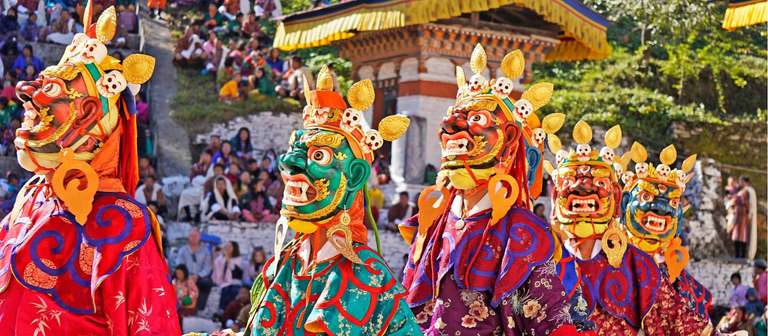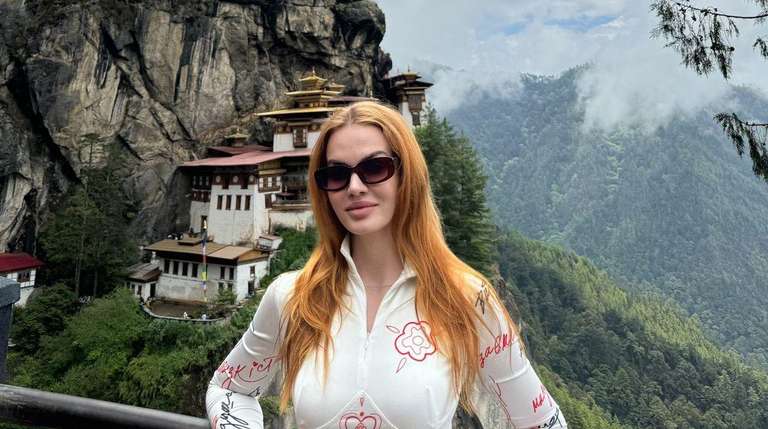Highlights
Traverse five Himalayan passes - including Sinche La (5005m) - on one of Bhutan’s most demanding and rewarding trekking routes
Experience life in Laya, a high-altitude village home to the resilient Layap people and their distinctive culture
Begin and end your adventure with visits to Bhutan’s iconic dzongs and sacred sites, including Paro’s cliffside Taktsang Monastery
Camp deep in remote alpine wilderness, among yak pastures, birch forests and glaciated valleys framed by high ridgelines
Itinerary
For those who seek adventure at the roof of the world, the Bhutan High Trails via Laya trek is the ultimate challenge. Over 18 days, experienced travelers and adventurous seniors cross high passes near 5000 meters, camping beneath sacred peaks and traversing breathtaking alpine meadows. The journey leads through vibrant forests and yak herder settlements, offering both natural wonders and deep cultural immersion. Time in Paro and Thimphu rounds out the experience, highlighting Bhutan’s rich heritage.
The USP of this trekking tour is its rare opportunity to access Bhutan’s remote heartland, providing an unmatched combination of high-altitude adventure and authentic local encounters.
day 1 - Join Paro (2200m)
After clearing customs and immigration you will meet your Bhutanese leader and drive a short distance via the main street of Paro to our accommodation. At some stage of our visit, we have planned visits to the main part of town, and a visit to the National Museum. It will depend on our time of arrival into Paro, and when trek preparations are completed.
The touring program will take in the grand Paro Dzong which dominates the valley and is the most important Dzong (fortress) in Bhutan. It is the model by which all other dzongs are constructed. The watchtower above it, Ta Dzong, is also an impressive building that houses the National Museum that is very informative. Old costumes and battle dress, together with priceless jewellery and specimens of the kingdom's unique flora and fauna are included within the museum. Downtown, there is a mixed collection of shops selling basic goods, and also handicrafts of wood, cloth and metalware. Archery is the national sport and practised throughout the kingdom. Shooting ranges lined by willow trees can be seen during our travels, as well as some traditional style bridges.
Overnight Hotel.
day 2 - Paro Valley, Taktsang Monastery (3100m) & National Museum
Today is a really exciting and informative day as an introduction to this wonderful country. The Paro Valley is truly beautiful, being a location for various farming activities, including commercial quantities of asparagus, strawberries and shitake mushrooms for export, plus various grain and vegetable crops. It is a patchwork of colours delineated by well kept traditional design farm houses that are ornately decorated. All of the slopes surrounding the valley are forested and the hint of mountains beyond is alluring. Our morning is spent exploring and appreciating the Tigers Nest Monastery or Taktsang, as it is known in Bhutan, a short drive from our resort. It takes us about one and a half hours to walk up the winding trail steeply through chir pine forest to a tea house and excellent vantage point. Another half hour walk takes us almost directly opposite the cliffs where the monastery is set. The monastery is the divine resting place of the Guru Ringpoche, and although it was once accidentally burnt down it has now been restored to its former glory. We return back to our accommodation for lunch and then some touring in the afternoon. This evening you will need to repack, leaving behind things you will not require on the trek for safe storage with our local partner.
Overnight Hotel.
day 3 - Drive past Drukyel Dzong (2580m) to Shana (2860m) and commence trek to Thongo Zampa (3250m), (11kms, approx 4 hrs)
It is a short drive of approx 20 minutes up the Paro valley to Drukyel Dzong, which was originally built as a fortress in 1647 to guard against Tibetans invading the Paro Valley. We continue the drive to Shana (1-1.5h drive) from where our trek commences. On this scenic drive we pass through farm country made up of fields of rice, wheat, barley, mustard, potato, and radish as well as herds of cows. The traditional Bhutanese two storey, timber and stone houses can be seen here. We also gain our first views of the summit of Jomolhari (7314m) at the head of the valley. We get under way and take a break for lunch where it suits us, as we are carrying a packed lunch. Initially the trail is wide and flat, as it meanders steadily through lightly forested fields, which in recent years have been the site of the ongoing large-scale Bhutan Government project to bring electricity to the isolated villages further up the valley.
Overnight camp Thongo Zampa.
day 4 - Trek to Soi Thangthangkha (3700m) (9km, approx 3-4 hrs)
We are now trekking within Jigme Dorje National Park, the largest protected area in the country (4350 sq kms.) which extends beyond Laya to Lunana in the east and all the territory to the south. Whilst it is a protected wilderness, the park management which is based at Gasa, has to cope with the needs of lowland farmers and semi-nomadic yak herders. There is an amazing variety of species of plants and animals in the park at both high and low altitudes. The forests are tall and thick, comprising a variety of oaks, maple, birch, larch pine and alders that will be replaced by more and more rhododendron and pines as we trek higher. There are numerous different varieties of the former, and depending on the onset of warmer temperatures after winter, flowers will be in bloom, or past bloom, as the lower altitudes flower earliest. As we climb higher the rhododendron species change from the common rhododendron arboreum (Nepal's national flower) to griffithianum and cinnabarinum. Many of the camps we stop at are not settlements as might be implied by them having a place name. Most are merely clearings beside a water source, which are also suitable camping sites for seasonal yak herders and workers who are involved in the large scale electrification project that will bring electricity to this region of Bhutan. Some of the camp sites with nearby settlements provide an opportunity to recharge your camera batteries and phones, with a minimal fees at times.
Overnight Camp.
day 5 - Trek to Jangothang (4100m) (12kms, approx 4-5 hours)
We continue higher to the camp at the base of Jomolhari, a superb alpine setting. Jichu Drake (6794m) rises to our right, with a fine, elegant ridge running down toward the pass that we will cross on our next trekking day. We camp in the vicinity of yak herders from the Paro Valley, who, like their counterparts in Southern Tibet, live in woven yak wool tents throughout the summer months. By now we are above the treeline and the area is characterised by low tundra of juniper and rhododendron setosum, while blue sheep have also been spotted in the higher rocky outcrops.
Overnight Camp.
day 6 - At Jangothang (acclimatisation day, hike to Tshophu twin lakes 4520m) (12kms, approx 4-5 hours)
Today we are at Jangothang, an important day for acclimatisation. A side trip up the small valley towards Jomolhari takes us to a dramatic viewpoint towards the glacier beneath. Alternatively we may make a scenic excursion up to Sopu Lake (4520m) set adjacent to Nye La pass, both will be worthy photo excursions. As far as mountaineering is concerned, these two peaks, like the rest of Bhutan, have seen little expedition activity from outsiders. Doug Scott successfully climbed Jichu Drake in 1988 on his third attempt, demonstrating that conditions are not so easy on this far east location of the Himalaya, being first in line geographically for monsoonal influences.
Overnight Camp.
day 7 - Cross Nyile La (4890m) to Lingshi Village (~14.5kms, approx 6-7 hrs)
From camp we commence our ascent over rolling slopes of grassland and small brush to the Nyile La (4850 metres). This is a relatively long day on the trail, so if this is your first Himalayan pass just take your time, particularly on the final steeper stages just below the pass, where grasses give way to scree and sand. The electrification project was a hard work on this pass where all the poles were carried by the local people. From the Nyile La we leave Jomolhari and Jichu Drake behind and make a steep descent through dwarf rhododendron shrub towards Lingshi village. In the distance we can soon see the Lingshi Dzong, built to protect this and the other outlying villages of Bhutan from the periodic raids from Tibet. Before we reach the village and the Dzong, we turn off descending to cross a stream, there is a short stiff climb and then a descent into the quiet valley and the camp of Chazhithang by a stream.
Overnight Camp.
day 8 - Trek to Chebisa (3880m) village (12kms, approx 5/6 hrs)
While those trekking just to the base of Jomolhari head out towards the roadhead today, we continue to head northeastward, ascending past the Lingshi Dzong (4200m) across high alpine pastures dotted with rhododendron and daphne to Chebisa. It is a picturesque valley of pastures and shingle roofed, stone houses. At its head, a short stroll from camp, is a tall waterfall cascading from a gap in rocky cliffs with a hanging lake behind. Beneath are stands of very tall, gnarled juniper trees. Our camp is next to the village so you will hear a lot of yak herder Tibetan mastiff and mixed breeds bark at night. These dogs guard the yaks and cattle from predators. Earplugs are recommended. Above Chebisa are the alpine pastures of the blue sheep and bharal that graze to the margins of the snowmelt during the summer months and descend way below the villages during the winter.
Overnight Camp.
day 9 - Cross Gombu La (4440m) to Shomuthang (4221m) camp (16kms, approx 7/8 hrs)
From Chebisa the trail gradually ascends to the Gombu La (4440 metres). The views back to Lingshi and the surrounding peaks are spectacular. Here, hill partridges have been sighted, while the griffons may be seen soaring above the alpine pastures. The descent to our camp beside the farm village at Shomuthang is through a forest of cypress then spruce and birch with large stands of rhododendron - griffithianum and campylocarpum. Iris and edelweiss may also be in flower. Our camp is set right beside the river in a small clearing surrounded by dense bushes.
Overnight Camp.
day 10 - Cross Jare La (4785m) to Robluthang (4165m) (18kms, approx 8/9 hrs)
Our route takes us directly upwards this morning, traversing around many grassy slopes to the Jare La. Blue sheep and griffons can often be seen here. Once at the gap, marked by flags and several cairns we can look expansively across to the adjacent valley and our next pass, the Shinge La. This pass is the highest and perhaps the hardest of our trek. The trail winds down through rhododendron, spruce, cypress and birch towards a broad valley floor where animals may be seen grazing. This may well be our first encounter with the people of Laya whom differentiate themselves by wearing the distinctive woven conical hats with a spike in the top and colourful beads draped around the back. Their 'mobile accommodation' as with all high altitude animal herders in this part of the world, is in heavy woven tents, usually made from yak wool. We trek several hundred metres in height up the opposite side of the valley to our camp in a hollow at Robluthang.
Overnight Camp.
day 11 - Cross Shinche La (5005m) to Lemithang (4150m) (16kms, approx 8/9 hrs)
It will take us approximately four hours to make our ascent of Sinche La. A slow steady pace is essential to gain it comfortably and make the long descent on the other side. At the pass itself there are glimpses of peaks to our left including Gangchenta. Descending, through boulders and grassy slopes, unparalleled views open out before us. Glacial blue lakes and white ribbon streams are set beneath the dramatic peaks of the 'Tigers Ears' Gangchenta. Further down, classic glacial erosion is at work, with fresh lateral and terminal moraine filling the valley floor along with an enormous milky grey lake. The forests are thick here, and our lovely riverside camp is surrounded by very tall conifers and the Tigers Ears as our backdrop.
Overnight Camp.
day 12 - Trek to Laya village (3800m) (13kms, approx 5/6 hrs)
This morning we walk directly away from the mountain environment before us, descending the valley to Laya and our first principle village of the trek. The forests are thick for the several hours; and the trail winds down beside the river steeply, until we reach pastures of the farmers of outer Laya. A swing in the trail brings us up to the main settlement which is spread out over a broad spur several hundred metres above the Mo Chu River. There are approximately 800 inhabitants in this high set village, and there is a school, hospital several small shops and a gompa to meet their needs. Life is not easy in this cooler, isolated location that is snowed in, in winter. Much of their living is reliant on yaks (meat, wool and dried cheese) and one annual crop of barley, mustard and turnips. Beneath the village is an army post protecting the frontier with Tibet, whilst above us to the east are spectacular views ahead to Masang Gang (7194m) and the region of Lunana where the 'Snowman' trek passes.
Overnight Camp.
day 13 - Rest day at Laya, explore local area
A day set aside to relax and rejuvenate after the exertions of the past few days. After a leisurely start to the day, we will enjoy some additional visiting time in Laya, threshing wheat with the locals, visiting the school or perhaps enjoying a soda in one of the small shops. Depending on logistics, we will either spend the night in Laya or descend down to the forested spur out of the village to the Mo Chuu River and camp at an army post that guards the frontier with Tibet.
Overnight Camp.
day 14 - Trek from Laya via Tongchudra to Taktsimakha, drive to Gasa (trek approx. 2-3 hours, drive approx. 2 hrs)
Initially our route takes a broad trail down, fairly steeply, through tall conifers to the river and army post. It then follows the course of the Mo Chu to the roadhead. The Mo Chu is a major Himalayan river that flows on through Punakha and then directly south to form the border between Assam and West Bengal, on into the Brahmaputra/Ganges and into the Bay of Bengal. The trail undulates down through beautiful forest of spruce, larch, birch, maple and rhododendron (sanguineum, cinnabarinum and arboreum). Be prepared for plenty of mud underfoot; these black fertile soils receive regular traffic of horse trains laden with goods/supplies travelling between Laya and the roadhead. Impressive waterfalls cascading over large boulders add yet another beautiful scenic dimension to our last day on trek. At Taktsimakha, our waiting vehicle will transport us to Gasa village (2850m), which serves as the local administrative and monastic center. The village is home to an impressive Dzong that historically guarded the trade route to Tibet. Below the village, we’ll visit the renowned Gasa hot springs, where we can relax our aching joints and celebrate the completion of our trek.
Overnight Camp.
day 15 - Drive to Punakha (drive approx. 2-3 hrs)
This morning we drive to the rich fertile valley of Punakha. The drive is around 2-3 hrs passing by the various villages and settlements on the way. The drive is beautiful through idyllic countryside past agricultural fields and sub tropical forest with waterfalls on the way. Once in Punakha, we visit the local bazaar before our excursion to the Punakha Dzong with its 21 temples, administrative buildings and Assembly Hall. It remains the winter residence of the ‘Je Khenpo’ - the head monk of the Drukpa sect - the Tibetan Buddhist sect that constitutes the official religious school of Bhutan. We can enjoy a short hike to visit Chimi Lhakhang, a small temple dedicated to one of Bhutan’s favorite saints, the “divine mad monk” Drukpa Kinley. This region was the stomping ground (nearly 500 years ago) of this rather unconventional character, who taught Buddhist dharma by employing an often shockingly ribald sense of humour.
Overnight Hotel.
day 16 - Drive to Thimphu via Dochula (drive approx. 2-3 hrs)
Today, we drive to Thimphu, the capital of Bhutan and home to around 150,000 people. Thimphu is a vibrant city where individuals from all corners of Bhutan have settled. Our journey takes us over the Dochu La Pass, where we will pause to admire the 108 stupas, built by the Queen Mother. At a scenic vantage point, we will hoist individual prayer flags for good luck. Upon arriving in Thimphu, our first stop is the Memorial Chorten, built in 1974 by the Royal Grandmother, Ashi Phuntsho Choden, in memory of the 3rd King, Jigme Dorji Wangchuck, who passed away in 1972. This revered site attracts Bhutanese from all walks of life, who circumambulate the stupa seeking merit and blessings. Following our visit, we will visit an atmospheric Bhutanese restaurant for lunch and check in to the hotel. After lunch, we continue our sightseeing with a visit to a viewpoint overlooking Thimphu, offering a stunning panoramic view of the city and we visit Buddha Point, home to the Buddha Dordenma, an enormous statue standing 169 feet (51.5 meters) tall. It is set amidst the ruins of Kuensel Phodrang, the former palace of Sherab Wangchuck, the 13th Desi Druk, and overlooks the southern approach to Thimphu. Depending on available time, we may also explore the Textile Museum, showcasing Bhutan’s rich weaving traditions, the Farmers’ Market, a vibrant market offering local produce and handicrafts, the Post Office - Bhutan's exquisite stamps are world-renowned, or a mill demonstrating Bhutan’s traditional paper-making process.
Overnight Hotel.
day 17 - Drive to Paro (approx 1-2hrs driving)
Today, we conclude our sightseeing in Thimphu, including an archery contest, offering a glimpse into Bhutan’s national sport, before setting out toward Paro. Upon arrival, we visit Dungtse Lhakhang, one of the sacred temples built across Tibet and Bhutan by Tibetan King Songtsen Gampo. This temple signifies the introduction of Buddhism in Bhutan, and its ancient murals remain well-preserved, offering a fascinating insight into Bhutanese religious art. You will have some free time to shop for any last-minute gifts and souvenirs at the markets in Paro. Later, you will enjoy a farewell dinner with your guide and driver, marking the end of this unforgettable journey to Bhutan, the Land of Happiness.
Overnight Hotel.
day 18 - In Paro, trip concludes
The trip concludes after breakfast with a transfer to the airport.
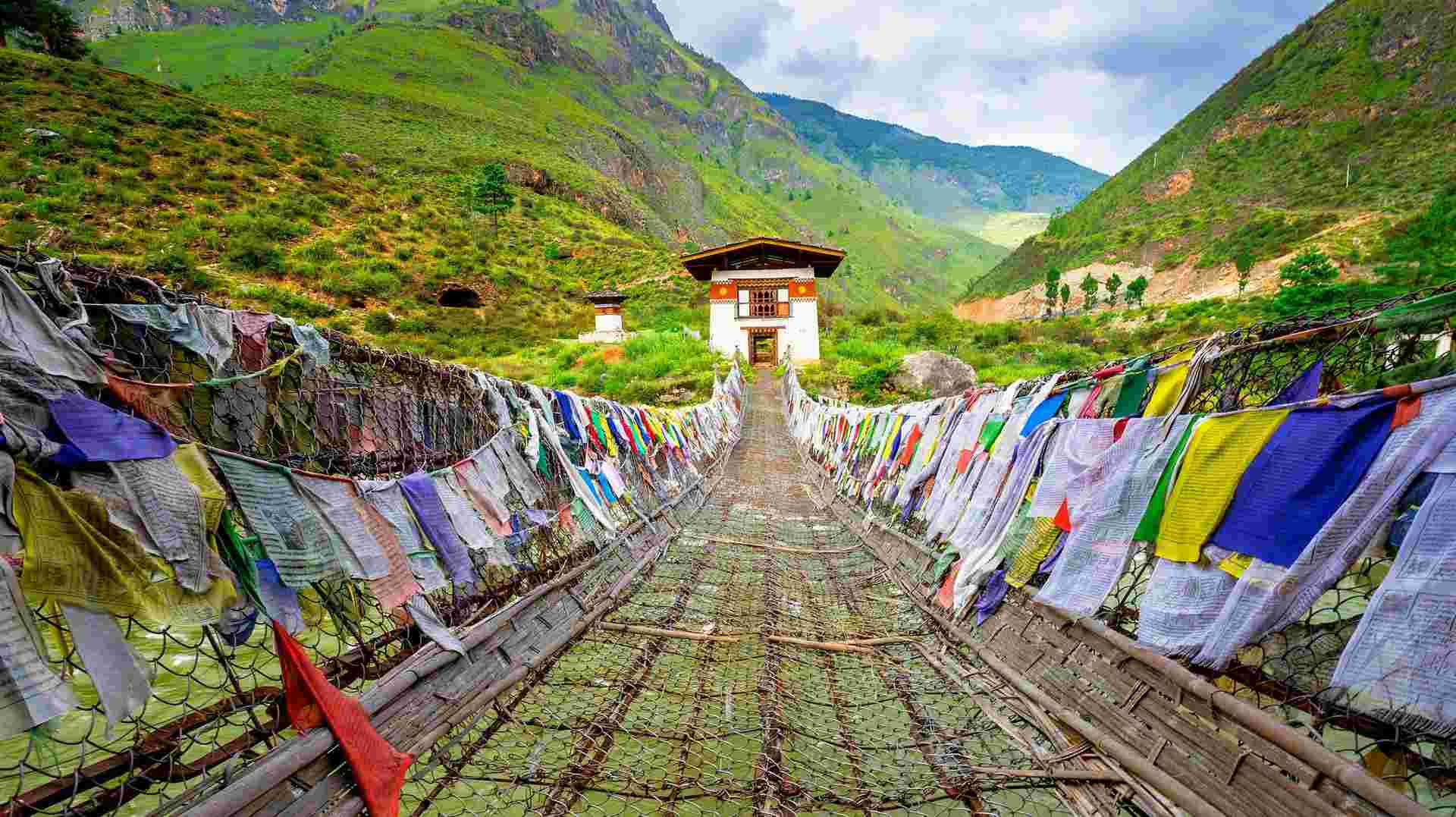
Get Trip Brochure & Exclusive Discount
Download a detailed PDF brochure and unlock an exclusive discount for this tour
What's Included
What's Excluded
Customer Reviews
Read what other travelers have to say about Bhutan High Trails via Laya
An amazing trek with such a great group of people
A truely wonderful experience on so many levels. I signed up for the physical challenge of the trekking and the high passes along with the scenery and isolation but in end it was so much more. Very personalised insights into the culture, society and history. Thoughtful discussions about Buddhism as we saw this being practiced first hand in the remote holy places. I got a sense of a World yet to be touched by the nasty sides of globalism. The chief guide was fantastic, a true gentleman and the camp staff and food was amazing for the high altitude and remote context. This is not though an easy walk and needs to be respected as such.
I have just completed the Bhutan High trails via Laya trip and would recommend this trip by World Expeditions without reservation. We happened to have near perfect weather, but our guide was unbelievably good: astute, sensitive, knowledgeable and passionate about his country. The views were spectacular,and the exposure to culture, village life, and Buddhist ways was a point of difference from other similar treks I have done (Huayhuash, Toubkal, Ladakh). The usual pleasures were daily highlights - great food, a hot drink at daybreak, and twice daily hot washing water. It was cold at night. We were all treated to hot water bottles. Small treats, but valuable a sub zero temperatures.
This was a wonderful trip, especially due to the guide and accompanying support staff. Thank you so much
Truly great experience in an amazingly beautiful and spectacular country. We had a great team to support us with Tashi our guide really awesome! The trek was well supported with good equipment, good catering and lots of nice touches like hot water bottles at night in the tent and a beautiful celebratory lunch at the conclusion. The walk itself was spectacular and well paced. I’d highly recommend this walk and this country with its wonderful people and amazing sights!
Tour Availability
Select your preferred departure date and secure your spot
Loading availability...
Good to Know
Do you need help from our trip consultants?
If you have any question about this tour or need help with planning a trip, please do not hesitate to get in touch with us.
Our travel experts are ready to help.


Why Book with Bookmundi
Earn USD 271+ in travel credits.
Best price guaranteed.
No credit card or booking fees.
100% financial protection.
Carbon neutral tours.
25,000+ trip reviews, with an average rating of 4.8 out of 5.

